

Holy Trinity
Amblecote

The word chalice is from the Latin ‘calix’ meaning cup and is a goblet used to contain the wine of the Mass, Holy Communion or Eucharist. Chalices have been made in a variety of precious metals mainly gold and silver or silver with a gold plated lining. In the past they have been made of onyx, horn, clay and glass.
Accompaniments to the chalice are:
The Purificator -
The Pall -

The word ciborium is from the Latin, ‘cibus’, "food" and this is a similar container to the Chalice but used to hold the wafers or host of Holy Communion. It differs from the chalice in that it is more round than conical and has a cover often augmented with a cross or other design.
Chalice
Ciborium
The paten Or ‘diskos’, is a small plate, usually made of silver or gold, used to hold Eucharistic wafers or hosts. It can be used in place of the Ciborium to distribute the host at Holy Communion.

Paten
This is a small box with a lid to contain the consecrated host. It can be used to carry communion to the sick and housebound.

Pyx
Middle English, from old French the diminutive of ‘crue’, flask of German origin. A small vessel which is normally made of glass, but can be a flagon of precious metals, which is used to contain the wine and the water which are mixed together at the consecration. Two vessels are always used one for each of the elements.

Cruet
From the Latin ‘monstrare’ which means to expose. This is used to display the consecrated host, or wafers, to the congregation during the service of Benediction. The priest blesses the people with the Eucharist displayed in the Monstrance. This blessing differs from the priest’s blessing, as it is viewed as the blessing of Christ, rather than that of the individual priest. When it is not displayed the reserved sacrament is kept in a locked Tabernacle or Aumbry.
Monstrance
This is a locked box in which the sacrament (host or wafers) is kept, reserved, for later distribution to the sick or to the housebound. At Holy Trinity it is built into the North wall of the Church.

Tabernacle
At Holy Trinity a white Sanctuary Lamp burns over the Aumbry to draw attention to the reserved sacrament, and a red lamp over the High Altar. These lamps burn 24 hours a day 365 days of the year.

Sanctuary Lamps

This is a metal censer suspended from a chain which is used to burn incense during certain services. Inside the thurible a lighted charcoal ring has incense placed on it. By swinging the thurible the incense is released.
The altar server who carries and uses this artefact is called the Thurifer.
Thurible
The boat is a container for granules of incense and the spoon is used by the priest to transfer these when needed to the thurible
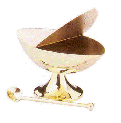
Boat & Spoon
The scallop shell has been used for centuries as a symbol of baptism. Ancient pictures show John the Baptist pouring water on the head of Jesus with a shell as he baptized him in the Jordan. Thus a shell may be used to administer the sacrament of Baptism.
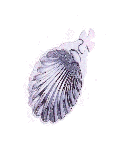
Shell
This is easy to identify being tall (up to 36") and usually decorated either with a wax relief or a transfer, it can also have grains of incense attached. The Pascal Candle is named after the Pasch (Pay-

St Augustine, the first Archbishop of Canterbury, is often claimed to have introduced the idea of a processional cross in the 6th Century. The Cross surmounts a long handle so that it may be held high enough for everyone to see. The cross leads the procession of choir, servers and clergy and the altar server who carries the cross is known as the Crucifer.

Processional Cross

Two of these are placed on either side of the monstrance during the monthly service of Benediction. The Menorah, or seven branch candlestick, dates back to Old Testament where it was used in the First and Second Temples.
Seven Branch Candlestick
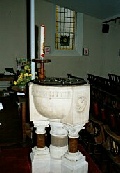
Baptism from the Greek 'baptizo' -
Baptismal Font
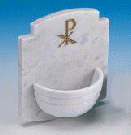

Pascal Candle
A small vessel, containing water from the font, is found by the entrance door of the Church. As a reminder of their baptism some worshippers choose to dip their fingers into the water when entering and then make the sign of the cross.
Water Stoup
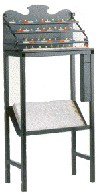
Votive or Prayer Candles
The Pricket stand holds votive or prayer candles. This will usually be found near to the statue/shrine of a Saint or near to the Reserved Sacrament. To have any meaning lighting a candle must always be an action accompanied by prayer.